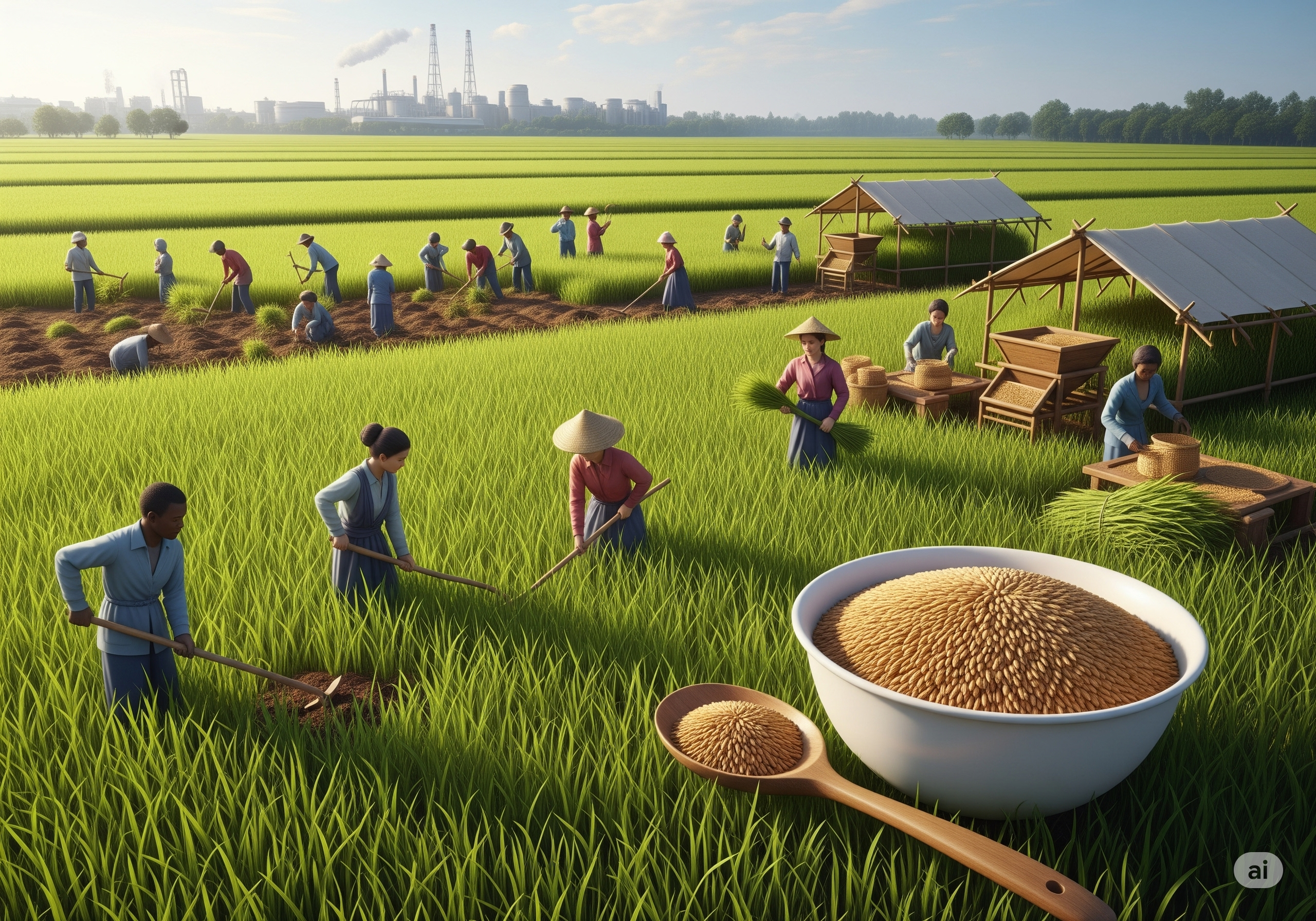

The Resilient Grain: Unearthing the Power and Promise of Jowar Flour (Sorghum Flour)
In the vast and varied landscape of global cereals, Jowar Flour, derived from the hardy sorghum grain (Sorghum bicolor), stands as a testament to resilience, nutrition, and cultural heritage. Often referred to as "great millet" or "milo" in various parts of the world, Jowar holds a venerable position in Indian agriculture and cuisine, particularly in the semi-arid and drought-prone regions. From its ancient origins to its modern resurgence as a gluten-free superfood, Jowar flour embodies a story of adaptation, essential nourishment, and growing global relevance, cementing its place in sustainable food systems and diverse dietary preferences.
The history of sorghum, and by extension Jowar, is deeply intertwined with the development of early agriculture, especially in Africa. Originating in Northeast Africa, particularly in Ethiopia and Sudan, around 8,000 years ago, sorghum was one of the earliest domesticated grains, cherished for its extraordinary ability to thrive in harsh environments. Its journey to the Indian subcontinent began millennia ago, where it quickly became known as 'Jowar' and assimilated into the local farming practices and culinary traditions. In India, states like Maharashtra, Karnataka, Andhra Pradesh, and Madhya Pradesh became strongholds of Jowar cultivation, relying on its inherent drought resistance to provide a stable food source even in challenging climatic conditions. Its deep roots and widespread adoption across diverse Indian communities underscore its historical significance as a cornerstone of rural livelihoods and food security.
The process of transforming Jowar grain into flour is relatively straightforward, yet it requires precision to achieve the desired texture and quality. After harvest, the sorghum grains undergo a thorough cleaning process to remove impurities, stones, and foreign matter. These cleaned grains are then milled into flour. Traditional methods involve stone grinding (chakki), which often produces a slightly coarser flour that retains more of the grain's natural character and sometimes a richer flavor. Modern industrial mills, on the other hand, utilize advanced machinery to produce finer, more consistent flour, which can be tailored for various baking and cooking applications. The resulting Jowar flour typically has a light, often milky-white to yellowish hue, depending on the specific sorghum variety used.
From a nutritional perspective, Jowar flour is a true powerhouse, offering a wealth of health benefits that make it an attractive alternative to more common grains. Its most celebrated attribute is that it is naturally gluten-free. This makes Jowar flour an invaluable dietary staple for individuals with celiac disease, non-celiac gluten sensitivity, or those actively seeking to reduce gluten in their diets. As the global demand for gluten-free options continues to soar, Jowar flour is perfectly positioned to meet this burgeoning need.
Beyond its gluten-free nature, Jowar flour is packed with essential nutrients:
High in Dietary Fiber: It is an excellent source of dietary fiber, both soluble and insoluble. This robust fiber content is critical for promoting digestive health, aiding in regular bowel movements, preventing constipation, and supporting a healthy gut microbiome. Fiber also plays a key role in satiety, helping with weight management by making one feel fuller for longer.
Rich in Protein: Jowar flour provides a substantial amount of plant-based protein, contributing to muscle growth and repair, and overall bodily functions. This makes it a valuable component of vegetarian and vegan diets.
Abundance of Minerals: It is particularly rich in vital minerals such as iron, magnesium, phosphorus, and zinc. Iron is crucial for oxygen transport and preventing anemia, while magnesium supports nerve and muscle function, and phosphorus is essential for bone health and energy metabolism.
Good Source of B Vitamins: Jowar flour contains several B vitamins, including niacin (B3), thiamine (B1), and riboflavin (B2), which are vital for converting food into energy and supporting various metabolic processes.
Antioxidants: While white varieties may have fewer tannins than darker sorghums, Jowar still contains beneficial phenolic compounds and other antioxidants that help combat oxidative stress and may offer protection against chronic diseases.
Low Glycemic Index (GI): Jowar flour generally has a lower glycemic index compared to refined wheat or rice, meaning it causes a slower and more gradual rise in blood sugar levels. This makes it a beneficial choice for individuals managing diabetes and seeking stable energy throughout the day.
In Indian cuisine, Jowar flour is a time-honored staple, especially in regions known for their hot and arid climates. Its most iconic use is in preparing Jowar Bhakri, a traditional unleavened flatbread that is a cornerstone of meals in Maharashtra, Karnataka, and parts of Rajasthan. These thick, rustic flatbreads have a distinct texture and earthy flavor, often served with hearty vegetable curries, dal, or chutneys. Jowar flour is also used to make various other traditional dishes, including nutritious porridges (often consumed for breakfast or as a fortifying meal), savory pancakes (like 'dhirde'), and even some traditional snacks. The flour's unique properties lend a distinct character to these preparations.
On a global scale, Jowar's versatility extends beyond traditional Indian kitchens. As 'sorghum flour,' it is gaining traction in international markets as a gluten-free alternative for baking, used in breads, muffins, cookies, and even gluten-free pasta. Its mild, slightly nutty flavor makes it adaptable to various recipes without overpowering other ingredients. Beyond human consumption, sorghum grain is a significant component of animal feed worldwide, especially for poultry, swine, and cattle, due to its energy content. It also holds potential in industrial applications, including the production of biofuels (ethanol) and various starches.
Economically, India's substantial production of sorghum places it as a key player in the global Jowar and sorghum flour market. The cultivation of Jowar provides a sustainable livelihood for numerous farmers, particularly in rain-fed areas where its resilience is critical. The growing domestic and international demand for Jowar flour contributes significantly to India's agricultural exports and foreign exchange earnings. Exporters like Naaviraexim play a crucial role in bridging the gap between Indian producers and international consumers, supplying high-quality, hygienically processed Jowar flour to markets in the UAE, Dubai, and Saudi Arabia, among others. The increasing recognition of Jowar's health benefits and its suitability for diverse diets fuels this growing export potential.
Despite its numerous advantages, Jowar flour faces certain challenges. Its unique texture and flavor might require adaptation for palates unfamiliar with it. Proper storage is essential to prevent insect infestation and maintain freshness, given its natural composition. Furthermore, increasing market awareness and overcoming traditional perceptions of it as a "subsistence crop" in some regions are ongoing efforts. However, the future of Jowar flour looks exceptionally promising. Its unparalleled ability to thrive in drought-prone regions makes it a crucial crop in the face of climate change. Ongoing research aims to develop higher-yielding varieties with enhanced nutritional profiles. As the world increasingly seeks sustainable, nutritious, and resilient food sources, Jowar flour is poised to take its rightful place as a leading global grain, nourishing communities and adapting to the challenges of tomorrow.